Securely managing large amounts of sensitive patient data remains the biggest challenge for the healthcare industry. Cybersecurity incidents with healthcare providers are reported globally with increasing frequency and severity. For example, in 2023, a data breach at HCA Healthcare impacted over 11 million patients of one of the largest healthcare systems in the United States.
This rapidly expanding threat landscape has turned the focus of healthcare organizations to adopting robust cybersecurity measures. One of the most promising technologies to secure healthcare data is the blockchain. Thanks to its decentralization, immutability, and transparency, blockchain technology is becoming a valuable tool for healthcare, revolutionizing the industry worldwide.
In this article, we discuss blockchain adoption in the healthcare industry, list the benefits of using the blockchain for healthcare, and explore major challenges of using the blockchain. This article will be useful for companies that develop or are considering developing blockchain-based solutions for the healthcare industry, as well as for healthcare organizations that are thinking about leveraging the blockchain to meet their needs.
Contents:
Unleashing the power of blockchain in healthcare
In recent years, the healthcare field has seen a huge increase in the amount of patient information. This includes electronic health records (EHRs), medical images, data from wearable health devices, and genetic information. As a result, healthcare organizations are dealing with more and more data.
Keeping this sensitive patient data safe is extremely important. Currently, this data exists in silos. Patients’ medical information is stored in various databases across different hospitals, private clinics, and insurance companies, which raises questions about data security and creates barriers to exchanging information. If the integrity and security of this information are not maintained, it can result in various problems, such as data leakage and unauthorized access to medical records.
Healthcare organizations need to work tirelessly to make sure that patient data stays secure. This is where the blockchain comes into play. Blockchain technology has emerged as a game-changer in the healthcare industry, revolutionizing the way data is managed and shared.
At Apriorit, our specialists already use the blockchain to solve various tasks across many industries. The main goal of our blockchain development services is to deliver efficient and secure products. This is exactly what the blockchain can add to the healthcare industry!
Seeking secure, transparent, and decentralized solutions for your industry?
Apriorit experts can help you design and build tailored blockchain solutions that will set you apart from the competition.
Top benefits of adopting blockchain technology
As a decentralized technology, the blockchain promises to ensure the incorruptibility and transparency of protected health information (PHI). In addition, the blockchain allows patients, doctors, and healthcare providers to share information quickly and securely, improves interoperability, and streamlines administrative processes.
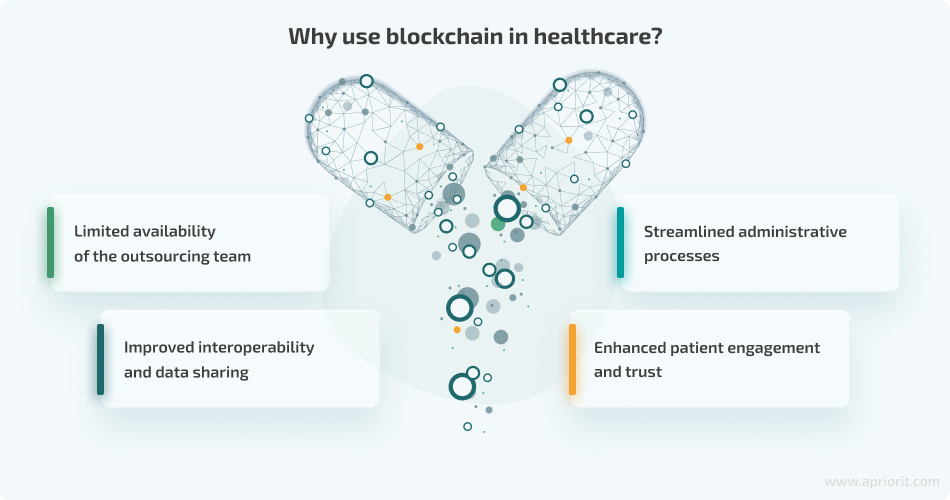
Enhanced data security and privacy
Blockchain technology offers an effective solution to one of the most pressing concerns in healthcare: data security and privacy. By design, the blockchain provides a tamper-resistant and transparent ledger that can guarantee the integrity of all information. Here is how this can be achieved:
- Unchangeable records can’t be altered without the consensus of network participants
- Encryption and decentralization eliminate the need for a single centralized authority and reduce the risk of data breaches
- Permissioned granular control allows only authorized personnel to access patient data
- Transparent data auditioning allows healthcare providers and patients to access an audit trail of all data interactions on the blockchain
Improved interoperability and data sharing
As we explain later in more detail, the lack of data interoperability is one of the biggest blockers for blockchain adoption in healthcare right now. The healthcare sector often struggles with the interoperability of various systems and data formats. As a result, healthcare providers, taxpayers, and patients can’t efficiently exchange information. The blockchain addresses this challenge in several ways:
- Unified data standards, formats, and protocols
- Real-time data access
- Cross-organizational collaboration between multiple healthcare organizations
Streamlined administrative processes
Administrative problems in healthcare might seem routine, but they can lead to increased costs and delayed patient care. With the blockchain, you can solve these problems by using:
- Smart contracts for automating billing, claims processing, and other administrative tasks
- Automation of various administrative tasks, such as verifying, reconciling, and processing healthcare transactions
Enhanced patient engagement and trust
Incorporating the blockchain into healthcare systems can boost client satisfaction, engagement, and trust. Here is how this can be achieved:
- Patient ownership of data gives more control to patients
- Improved data accuracy increases patients’ confidence in the accuracy and security of their medical information
- Secure telemedicine provides private and authenticated data sharing and online consultations between patients and their healthcare specialists
The benefits of blockchain in healthcare can be realized through a variety of use cases, including electronic health records, telemedicine, and many more. Let’s take a look at applying blockchain to healthcare today.
Read also
Blockchain Opportunities in Healthcare and Pharma
Check out our article about blockchain opportunities in healthcare and pharma. Whether you’re a healthcare professional, a developer, or are simply curious about the future of healthcare, you will see how the blockchain can revolutionize these industries.
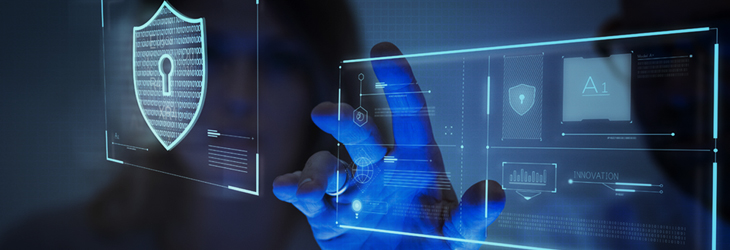
8 use cases and applications of blockchain in healthcare
Managing PHI isn’t the only way blockchains can be applied for medical purposes. Let’s explore the most relevant blockchain use cases in healthcare.
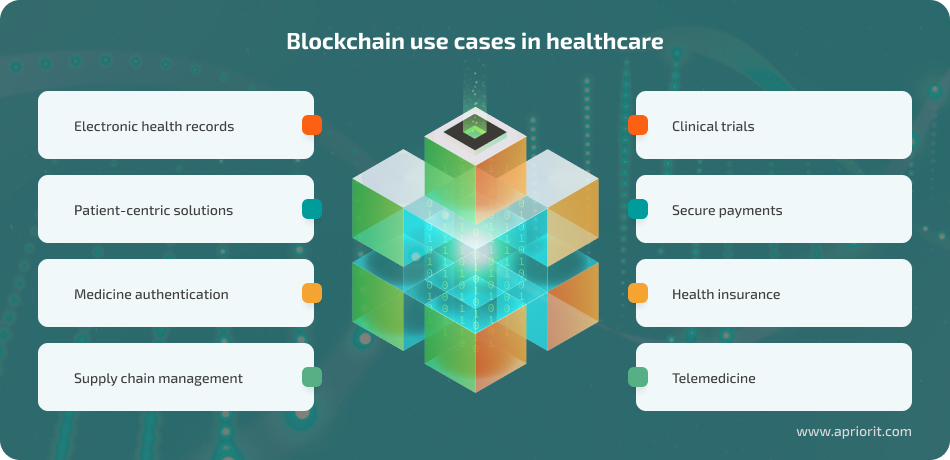
Electronic health records (EHRs). If you need to build an EHR system, blockchain can help you solve issues of data security, integrity, and management. Thanks to decentralization and cryptographic functions, blockchain-driven applications allow patients and medical institutions to securely control health data, manage access to it, and ensure its privacy.
Medicalchain and Gem Health Network are excellent examples of blockchain in healthcare to securely store and share medical records between patients and different healthcare providers. These platforms are used to improve the efficiency, security, and transparency of EHRs.
Patient-centric solutions. Patients can share their PHI collected by smart fitness devices or medical records from other institutions with doctors to ensure quick and convenient communication. Blockchain can also give patients more control over their own healthcare data with a personal health record (PHR) that is owned and controlled by the patient.
Patientory and Solve.Care give patients more control over their medical data and make it easier for them to share it with healthcare practitioners. Patientory uses the blockchain to create a secure and tamper-proof record of a patient’s medical data. Solve.Care leverages the blockchain to create a decentralized healthcare ecosystem where patients can own and control their own medical data.
Medicine authentication. The blockchain’s ability to establish an immutable transaction history can be used in the pharmaceutical industry. Blockchain-powered pharma solutions can verify the origins of medical drugs and identify fake medicines.
For example, MediLedger and Chronicled can be used to track the movement of prescription drugs and prevent counterfeit drugs from entering the market. The MediLedger network is based on Ethereum and uses Proof of Authority consensus, multi-access smart contracts, and multiple smart contracts for business protocols.
Supply chain management. Medical drug traceability can also enhance supply chain management. Interoperability between blockchain networks can allow pharmaceutical companies to track their products’ movements from the source to the end consumer. Some projects already combine blockchains with the Internet of Things (IoT) and artificial intelligence (AI) for planning manufacturing processes and forecasting demand for certain drugs.
For instance, FarmaTrust provides blockchain and AI-based provenance systems for the pharmaceutical and healthcare sectors. It aims to ensure advanced tracking, planning, and forecasting capabilities for pharmaceutical companies.
Clinical trials. Such trials involve multiple parties: study subjects, study sponsors, drug manufacturers, medical device providers, doctors, researchers, etc. A successful medical trial requires privacy and fast and secure data exchange. When implemented in clinical trial systems, blockchains reduce the risk of data fraud thanks to their consensus mechanisms and decentralized structure.
Using blockhain, clinical trial documentation can be secured with a Proof of Existence mechanism. By providing a secure and tamper-proof way to store and share research data, the blockchain can accelerate the pace of scientific discovery and improve the quality of research. For example, PokitDok is a platform that provides a secure and transparent way to manage patient consent and enrollment in clinical trials. PokitDok uses Hyperledger Sawtooth as the underlying ledger for its DokChain blockchain platform.
Secure payments. Payment-related claims often arise due to human mistakes, overdue payments, and fraud committed with stolen patient identities. The blockchain’s security capabilities promise to improve transactions within the healthcare industry by minimizing denied claims, quickly reporting underpayment, reducing human errors, and better securing patients’ identities.
Ripple and Stellar are both blockchain-based payment networks that provide patients with a fast and secure way to pay for their medical services. Ripple offers a feature called xRapid that allows users to instantly exchange XRP for fiat currencies. Stellar also offers a feature called Stellar Anchor that allows users to bridge Stellar and traditional payment systems.
Health insurance. When used in insurance applications, the blockchain can optimize patient data management and reduce regulatory and compliance costs. It can also improve interactions and secure payments among healthcare professionals, insurance companies, and patients. Moreover, the data transparency offered by blockchain technology can help solve the issue of multiple intermediaries throughout the lifecycle of a health insurance policy.
For example, CuraBlox is a blockchain-based tool designed to simplify claim identification and payment administration within healthcare organizations. It aims to help providers manage the value-based reimbursement model and save time on administering value-based contracts.
Telemedicine. Telemedicine is the delivery of healthcare services over the internet. It is a rapidly growing field, and blockchain healthcare projects have the potential to revolutionize it, allowing patients to consult with their doctors remotely.
For instance, Patientory and Solve.Care use blockhain to allow patients to securely connect with their healthcare providers via the internet, pay for their services, and share medical data.
Now that we’ve listed how blockchain is being used in the healthcare field today, let’s take a look at possible pitfalls when developing blockchain-based medical solutions.
Related project
Building an AI-based Healthcare Solution
Take a look at how we partnered with a US-based healthcare center to develop a robust AI-based system. We created a solution that could track ovarian follicles across video frames, detect them in ultrasound images, and measure them with a high level of accuracy.

Overcoming barriers to blockchain adoption
Although blockchains can potentially solve various issues within the healthcare industry, implementing them isn’t easy. The convergence of blockchain and healthcare systems causes several challenges with data (related to standards, accuracy, and privacy) and reveals general issues that still exist with blockchain implementations, like lack of scalability, poor standardization, and slow transaction speeds.
Let’s take a look at the biggest challenges of blockchain in healthcare industry:
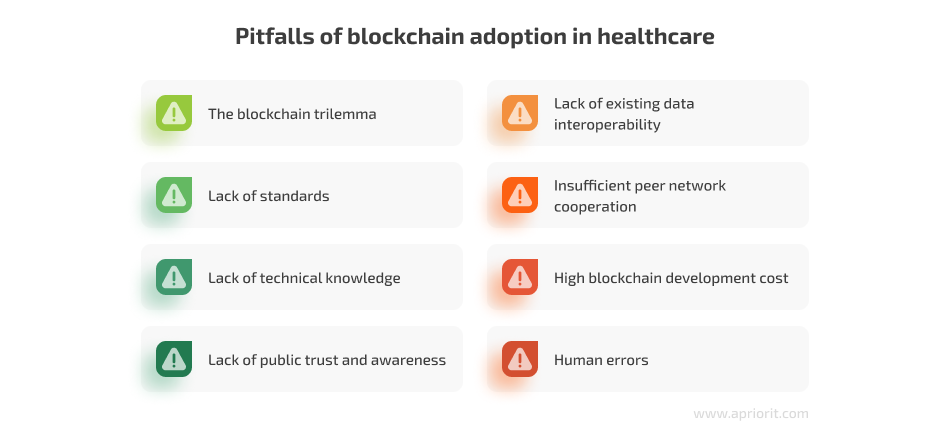
The blockchain trilemma. Also called the scalability trilemma, this term describes the issue of ensuring perfect scalability and security without sacrificing the possibility of decentralization. The blockchain trilemma states that you can’t maximize scalability, security, and decentralization at the same time. This challenge raises concerns about the security of possible crypto payments for medical services. When adopted globally, crypto payment services may fail to ensure proper security and decentralization when handling millions of transactions simultaneously.
How to solve this challenge? Layer-2 scaling solutions such as rollups and sidechains can help to improve the scalability of Ethereum and other blockchain networks.
Lack of standards. The blockchain still lacks universal standards, not to mention the lack of regulation within the healthcare industry. An absence of common standards can create a mess in healthcare. Patients can’t be sure their private data is secure just because a healthcare provider claims to use a blockchain. Legal requirements should also be applied to smart contracts that may be used in medical facilities to arrange payments and handle claims. Also, there are some concerns that PHI encrypted using mathematically derived methods can potentially be re-identifiable, which violates HIPAA requirements.
How to solve this challenge? Governments and regulatory bodies around the world are developing new regulations for blockchains and cryptocurrencies. This is expected to provide more clarity and certainty for businesses and investors. Health Level Seven (HL7) International is developing a standard for exchanging healthcare data for blockchain using the Fast Healthcare Interoperability Resources (FHIR) standard.
Lack of technical knowledge. Another issue that explains why medical facilities don’t choose to use blockchains is a lack of understanding from healthcare practitioners. This situation has changed as existing blockchain-driven healthcare solutions show their benefits and encourage competitors to come on board.
How to solve this challenge? The American Medical Association (AMA) has published educational resources about blockchain technology for its members. More and more healthcare organizations offer materials and training to healthcare providers.
Lack of public trust and awareness. For the average person, blockchain is associated with cryptocurrency and trading. People don’t realize the potential applications of this technology in other spheres, and this lack of awareness can create a barrier to adoption. Also, there is a risk that patients might not be comfortable sharing their medical data on a blockchain platform.
How to solve this challenge? The US Department of Health and Human Services (HHS) has published a guide on blockchain technology for healthcare stakeholders. Also, many blockchain technology companies, such as Chronicled and MedRec Blockchain, are developing educational resources for healthcare providers and patients.
Lack of existing data interoperability. To adopt blockchains globally and use them to the fullest, a huge number of organizations will need to be open to cooperating and exchanging data. These organizations include healthcare providers, pharmaceutical companies, governmental organizations, health insurance organizations, and various intermediaries who are obliged to protect their patients’ data and, therefore, hesitate to freely share patient information.
How to solve this challenge? The MedRec Blockchain Consortium is developing a blockchain-based platform for sharing medical records between different healthcare providers.
Insufficient peer network cooperation. It can take years to organize a large number of peers to handle silos of sensitive data and quickly and securely reach consensus among multiple parties. To create complex healthcare networks, data standards for blockchain ecosystems and a universal approach to blockchain networks should be established first.
How to solve this challenge? The Hyperledger Fabric project is developing a blockchain platform designed for enterprise use cases, including healthcare.
High blockchain development cost. Planning, building, and maintaining blockchain solutions for healthcare takes up a lot of resources, including time and money. Even though the market is growing rapidly, developing a blockchain solution for healthcare is still a complex and expensive undertaking. This is because healthcare organizations need to work with large volumes of medical records and must comply with strict data privacy and information security requirements.
How to solve this challenge? Even though it’s still a challenge, the cost of developing and maintaining blockchain solutions is currently decreasing. Also, you don’t have to develop a blockchain network from scratch; forking an existing blockchain platform might be enough for your solution.
Human errors. When powered with a blockchain, data management is likely to be faster, more efficient, and more fail-safe than when it’s handled by people. However, the way medical records have been treated in the past can bring new issues, and a blockchain can’t protect medical systems against human errors. For instance, if your personal data is entered incorrectly, the blockchain system will save it as is.
How to solve this challenge? Blockchain-based healthcare solutions are being developed to automate tasks such as medical records and insurance claims processing. Blockchains can reduce human error and inconsistencies in medical coding by automating the process with smart contracts and AI. This can reduce the risk of human error and provide a tamper-proof data record.
Related project
Decentralized Blockchain Application for International Remittance Payments
Check out how we partnered with a financial services provider to improve their Ethereum-based solution.
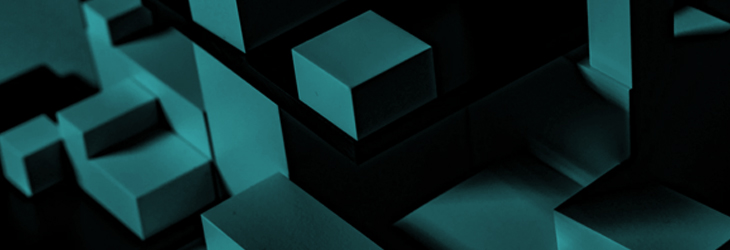
Conclusion
Today, healthcare software development leaders are increasingly recognizing the blockchain’s potential to improve the efficiency, security, and transparency of healthcare data management. Such technology can bring new opportunities to healthcare organizations and help patients securely and conveniently manage their records. To start preparing for the future, medical institutions should consider implementing blockchain-based solutions right now.
The best way to do this is to choose a blockchain development company that stresses security when building custom blockchain solutions based on your requirements. At Apriorit, we have a dedicated and experienced blockchain team that’s ready to share their expertise and turn your ideas into a robust healthcare solution.
Looking for a way to optimize operations through blockchain technology?
Apriorit experts can build a blockchain-based system that will boost the efficiency of your business.


